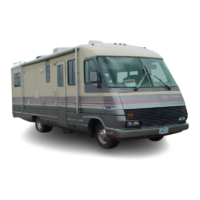61
Discovery, Discovery LXE, Pace Arrow, and
Strong detergents, alkaline
or acidic cleaners, acids
or lye-based chemical
products or solvents.
Inside:
If the tires are removed, inspect
and clean the entire rim. Air used
to ll the tire may contain moisture
and can cause the areas of the
wheel under the tire to severely
corrode. Use a soft brush to
remove foreign material from the
tire side of the rim. Lubricate the
rim and tire bead with a non-water-
based lubricant before mounting
the tire and ensure the inside of tire
is dry before installing.
WARNING:
Do not use a flammable
solution to coat the
inside of the rim. This
can lead to an explosion
during tire inflation or in
subsequent operation of the
motorhome.
EXTERIOR MAINTENANCE
The motorhome is exposed to
extreme temperatures, humidity,
ultraviolet rays, rain and other
environmental conditions. While in
operation the motorhome is subject
to twisting and exing caused by
rough roads, potholes and winding
mountain roads. Maintenance is
necessary not only to keep the
exterior looking nice but also to
keep it in proper working order.
Fiberglass
Inspect the berglass exterior.
Periodic inspection may reveal that
exing of the berglass exterior
has created imperfections in the
surface commonly known as
“spider” or “hairline” cracks. A
crack that has opened up to reveal
the cloth weave threatens the
integrity of the berglass. If the
exterior exhibits signs of damage,
prevent moisture penetration,
particularly in freezing climates.
Cover the area using plastic
sheeting and/or tape, and have the
damaged berglass repaired as
soon as possible.
Roof Care & Seal Inspections
Wherever there is something
afxed to the motorhome, such as
the “beltline” or vent attached on
the roof, there is a seal preventing
water intrusion.
There are many types of sealants
and each has a specic use. While
the beltline uses a silicone or
urethane base sealant to prevent
water intrusion, roof openings use
an acrylic based sealant. Moisture
intrusion can occur at any time for
a number of reasons. Therefore,
regular sealant inspection and
maintenance will greatly reduce
the likelihood of moisture
intrusion and costly repairs.
The motorhome is sealed at
the factory. However, extreme
weather conditions can shorten
the life of the sealant. Harsh road
conditions can compromise sealant
integrity. Maintaining sealant
is part of regular motorhome
maintenance. Inspect all joints,
seams and openings at least once
every six months. While sealant
integrity may appear ne, a small
void under the right conditions
can quickly cause major damage.
Make a full interior inspection for
signs of moisture intrusion every
two weeks if the motorhome is in
storage.
CAUTION:
Inspect exterior seals,
seams and joints for sealant
integrity at least twice a
year. Make a full interior
inspection for water leaks
every two weeks while the
motorhome is in storage.
INSPECTION:
Surface must be clean
and dry. Inspect seal for
voids, cracks, bubbling,
peeling or pulling away.
Sealant that looks fine
without imperfections is
acceptable for continued
service. Sealant that is
old, cracking, flaking
or bubbling will allow
moisture intrusion and
must be repaired.
WARNING:
Inspecting sealant will
require use of a ladder or
scaffold assembly. Roof
access is also required.
Follow proper safety
measures accordingly.
Exercise extreme care
whenever using a ladder/
scaffold assembly. Avoid
getting on the roof if it is
icy or moisture laden as the
surface can be very slick.
Use judgment if inspection
is considered dangerous.
Have the motorhome
inspected or sealed (if
necessary) by a qualified
service technician.
Sealant Replacement:
Carefully remove sealant that
is cracking, aking, bubbling,
peeling or pulling away from
the surface. The area under the
removed sealant will need to be
clean and dry before applying new
sealant. Applying new sealant over
a dirty or moisture laden surface
will not allow proper adhesion.

